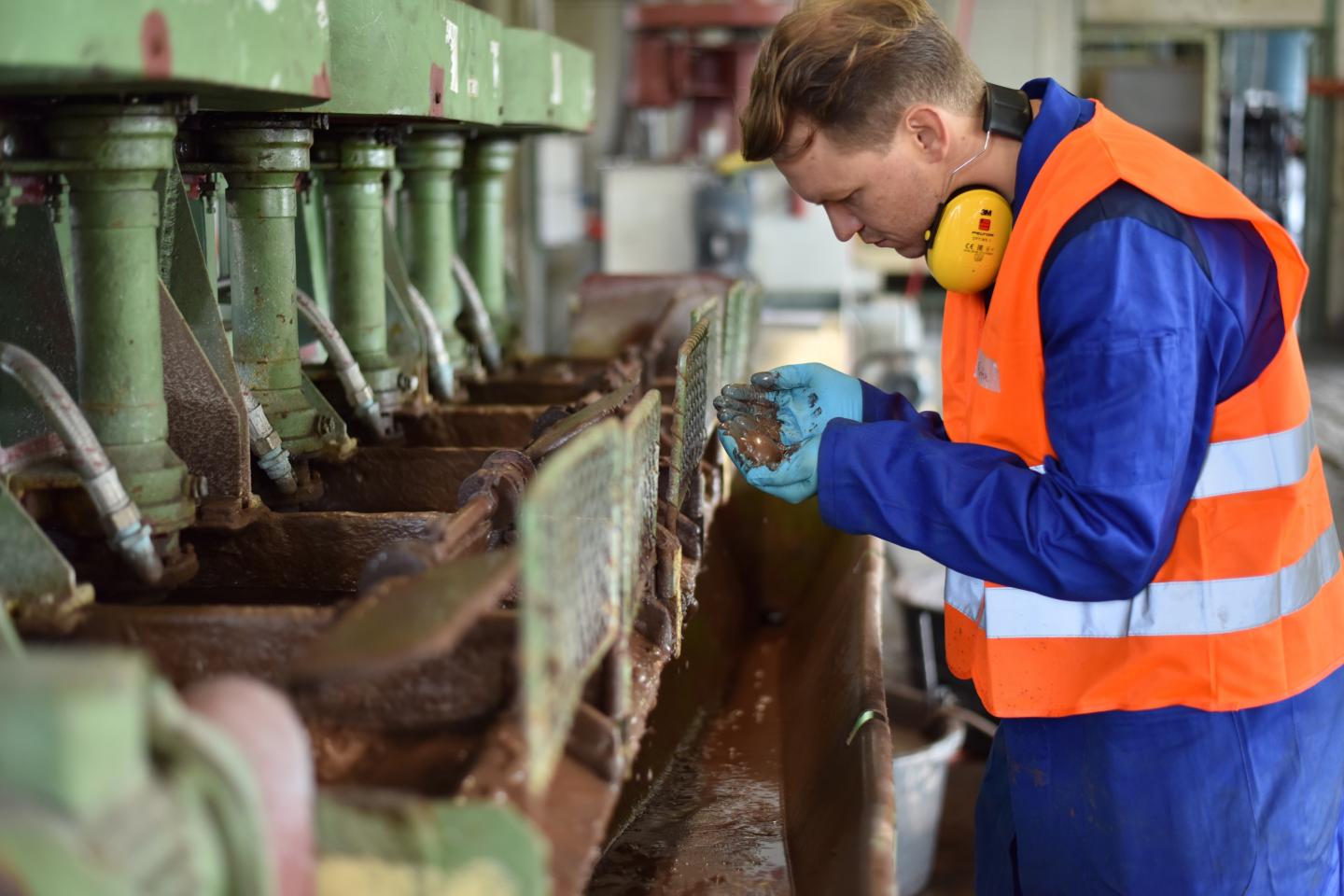A new EU project explores innovative technologies and concepts for recovering ultrafine particles of raw materials

Credit: HZDR/Robert Möckel
Critical raw materials such as copper, cobalt, and rare earths are of strategic importance to the European economy. However, the ore grain size of many of these metals remaining in deposits are too small to be separated using the standard process of flotation. In the FineFuture project, a consortium of 16 partners from industry and science therefore seeks to explore fine particle flotation phenomena and to develop new technological solutions for this process. The three-year project has received over €6.2 million in funding from the EU. FineFuture is coordinated by Helmholtz-Zentrum Dresden-Rossendorf (HZDR).
Europe currently accounts for just three percent of global mine production – compared to 40 percent in the year 1900. But there are now signs of a turnaround. The reasons for this development are rising prices and the growing global demand for strategically important, technologically interesting metals. Deposits previously considered uneconomic to mine are now increasingly becoming the focus of the mining industry: these sought-after, yet low concentrated ores are finely dispersed in the rock, meaning that tremendous technological effort is required to recover them.
“The issue of raw materials can only be addressed at the European level,” emphasized Professor Kerstin Eckert from the Institute of Fluid Dynamics at HZDR, which is coordinating the whole project: “With the consortium’s combined expertise, we have the chance to make substantial improvements in the yield and recovery rate.” The FineFuture project involves cooperation between partners from a total of eleven countries; their aim is to combine progressive facility design and process innovations to achieve a 30 percent higher recovery rate in the future. In addition, more efficient techniques involving fewer process steps should reduce water and energy consumption and minimize the discharge of chemicals to the environment.
What is flotation?
“In the metals and minerals industry, froth flotation is the most important way of recovering valuable raw materials from ores,” explained Dr. Martin Rudolph from the Helmholtz Institute Freiberg for Resource Technology (HIF), which belongs to the HZDR. “However, recovery of particles below 20 micrometers in size – which is less than half the thickness of a human hair – is beyond the capabilities of current flotation technologies.” Froth flotation exploits the differences in the surface properties of mineral particles. If gas bubbles are added to a liquid with finely ground particles, the bubbles adhere to particles with a hydrophobic (i.e. water-repellent) surface. These particles, with air bubbles attached, then rise to the surface and form a froth layer, which can be skimmed off. Reagents tailored to the relevant recoverable material ensure that the “right” particles find their way into the froth. Other auxiliary substances cause non-target particles to sediment to the bottom or stabilize the valuable froth. Factors such as the quantity of gas added, the bubble size, the degree of turbulence in the flow, the reagents used, and adhesion energies determine the yield.
“And yet how can effective collisions between fine particles and bubbles be induced?”, asks Rudolph, who leads the Processing department at the HIF. “How do the different reagents affect the overall process? And how can non-target particles be removed from the froth?” Many fundamental questions have yet to be answered before mineral particles in the range of 0.1 to 20 micrometers can be separated on an industrial scale in the future. Such a technology would also be of major importance for recycling or for recovering raw materials from old heaps.
Computer modeling of fine particles in pulp and froth
Research undertaken by the nine academic project partners mainly focuses on developing a better understanding of the mechanisms and microprocesses involved in fine particle flotation: two of the nine work packages concentrate on the physico-chemical and hydrodynamic aspects of processing. These include the binding mechanisms and frothing characteristics of the valuable particles, and turbulent flows in the flotation tank. The latter influence the collision frequency of particles and bubbles: adhesion is only possible when air bubbles come into contact with hydrophobized mineral particles.
No less than three groups at the HZDR are working to improve the yield of fine particle flotation: not only Kerstin Eckert’s team, but also colleagues from the Department of Computational Fluid Dynamics and a research group led by Martin Rudolph. Using model experiments, newly developed measurement methods and computer simulations, they investigate flow conditions in the flotation bath, which cannot be seen from the outside, and how particles, fluids and gas bubbles interact.
A benefit for the environment
The partners hope that their research results will enable them to derive approaches, such as innovative hydrodynamic concepts, that can be used to increase the probability of bubbles colliding with fine particles. This is where the know-how and technology of flotation cell manufacturers comes in. The researchers want to exploit insights into interface interactions to improve the adhesion of ultrafine valuable particles to the gas bubbles by optimizing reagents. The newly developed technologies will then be tested and optimized in simulated environments, in the laboratory, and in pilot plants.
In addition to leading European research institutions, seven companies from the areas of mining, the materials processing industry, and machinery and plant engineering are involved in FineFuture, including the Polish corporation KGHM – one of the world’s largest mining groups and copper mine operators – and three other raw materials companies. Besides aspiring to achieve higher recovery rates, these companies hope to develop processes that are more sustainable and that generate fewer flotation residues. Moreover, many heaps still contain valuable fine particles, which they wish to exploit. This development could decrease the size of landfill sites, resulting in a reduction of land consumption and of environmental dangers. Being a manufacturer of flotation chemicals, BASF is also a member of the project. The company wants to develop optimized reagents that are more economical, effective, and therefore more environmentally friendly.
FineFuture partners:
- Coordinator: Helmholtz-Zentrum Dresden-Rossendorf (HZDR)
- Aristotle University of Thessaloniki, Greece https:/
/ www. auth. gr/ en - BASF, Germany https:/
/ www. basf. com/ global/ de. html - Eramet, France http://www.
eramet. com/ en - Grecian Magnesite, Greece http://www.
grecianmagnesite. com/ - Imperial College London, Great Britain https:/
/ www. imperial. ac. uk/ - Industrial Minerals Association Europe, Belgium https:/
/ www. ima-europe. eu/ - Institute of Non-Ferrous Metals, Poland http://www.
igmnir. pl/ en/ members/ institute-of-non-ferrous-metals-in-gliwice - Istanbul Technical University, Turkey http://www.
global. itu. edu. tr/ - KGHM Polska Mied?, Poland https:/
/ kghm. com/ en - Maelgwyn Mineral Services, Great Britain https:/
/ www. maelgwyn. com/ - Magnesitas Navarras, Spain https:/
/ www. magnesitasnavarras. es/ - Politecnico di Milano, Italy https:/
/ www. polimi. it/ - Sofia University, Bulgaria https:/
/ www. uni-sofia. bg/ eng - Turboflotservice, Université de Lorraine, France http://welcome.
univ-lorraine. fr/ de
Some of the partners are members of the “NetFlot” network, which was established three years ago in a bid to pool competence on flotation at the European level and to strengthen its presence on the international arena.
###
Media Contact
Dr. Christine Bohnet
[email protected]
Original Source
http://www.




